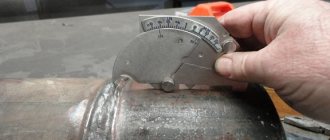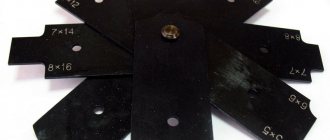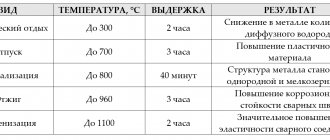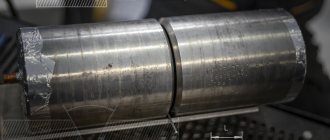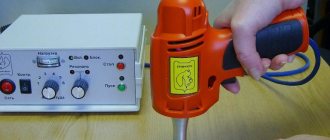What is UZK
Ultrasonic testing is a non-destructive method of testing welded joints with ultrasonic transmission of the joint section being tested to identify internal welding defects and deviations in the chemical composition of the metal from the norms established by current standards.
Such flaw detection can reveal slag inclusions, air cavities, the presence of non-metallic components, and chemical heterogeneity in the metal structure.
The principle of ultrasonic testing is based on the property of acoustic waves to maintain straightness when passing through a homogeneous medium. Radiation with a frequency of over 20 kHz easily penetrates the welding seam. In the presence of defects, the rays are reflected from the surfaces of internal voids and change the trajectory due to the heterogeneous composition of the substance.
Deviations are recorded using special equipment. On the monitor, the flaw detector sees the readings obtained based on the amplitude values of the received signal and the amount of time required for the impulse to cover a given distance. As a result, the nature, location and size of defects can be determined quite accurately.
Editor's Choice
When choosing ultrasonic and eddy current flaw detectors, we recommend paying attention to the products of SPC Kropus . The company has many years of experience in the development of instruments and substances for non-destructive testing. This is a Russian company, so you can count on an adequate price-quality ratio.
For radiographic testing in field conditions, the Arion-300 . Also made in Russia. It is distinguished by its compact size and high accuracy of defect detection. The focal spot diameter is 2.3 mm, which allows you to obtain a clear image of defects of a similar size. At the same time, the device is capable of shining through steel products with a thickness of 60 mm.
In the field of magnetic particle and capillary testing, there is practically no equal to the English company MAGNAFLUX . Its devices and consumables are affordable and come in a wide range.
Design and principle of operation of an ultrasonic flaw detector
All ultrasound diagnostic devices have a similar design, since their operation is based on a common principle. The set of equipment used for ultrasonic testing of welded joints consists of:
- Emitter;
- Amplifier;
- Receiving block.
The flaw detector sets the modulation of pulses, taking into account the characteristics of the metal and the features of detected violations of welding technology. Sound waves are converted by the device into electromagnetic pulses, displayed on the oscilloscope display. To ensure that the interface of the media less distorts the received signal, the surface of the seam is treated with a special gel.
Based on the ultrasound parameters at the output, it is possible to determine the depth of location and size of defects. Carrying out work requires the involvement of trained and certified specialists who have received expert qualifications and are able to work with specialized diagnostic equipment.
Vector-50 (NPC "Kropus")
at a price of 280,000 rubles.
Vector-50 is a model of an eddy current flaw detector from a constantly updated line from the Kropus Research and Production Center. This is the largest Russian manufacturer of NDT equipment, so its products could not fail to be included in our review.
Model features
The device is universal, because Supports any eddy current and impedance converters. This makes it possible to assess the condition of metal, carbon fiber and composite products, to identify surface and subsurface cracks and discontinuities in them. The device can be used as a thickness gauge and to determine the electrical conductivity of non-ferrous metals.
In addition to its compact dimensions (200x225x80 mm) and low weight (1.5 kg), the equipment has a color display with a resolution of 640x480 pixels and connects to a computer via USB. The device memory can store 100 settings and 500 control protocols.
Among the features is the display of the signal on the display in two planes: complex and amplitude-time. Various signal visualization modes are available. There is also the possibility of separate amplification along the abscissa and ordinate axis. The device can be used with rotary transducers for hole inspection.
The flaw detector is powered from a 220V network or battery.
In the second case, the maximum battery life is 10 hours. Technical characteristics* Vector-50
| Parameter | Meaning |
| Operating mode | standard, synchronous, frequency scanning |
| Gain adjustment, dB | 0-70 in steps, 0.1, 1, 2, 6 or 10 |
| Frequency change, Hz | 1-20×106 in increments of 1, 10, 100 or 1000 |
| Low-pass/high-pass filter, Hz | 5-1000/2,5-500 |
| Types of suitable converters | rotary, absolute, differential |
| Operating temperature, °C | -30…+55 |
| Dimensions, mm | 200×225×80 |
| Weight, kg | 1,5 |
*See the full list on the official website.
See how this flaw detector works in tandem with a rotary sensor to detect surface cracks in bolted process holes:
Scope and possibilities of application of the technique
The ultrasonic testing technique is quite universal and allows you to accurately identify welding defects under various inspection conditions. But it is necessary to take into account certain limits that limit the capabilities of this flaw detection.
Ultrasound is used to detect the following violations of welding technology:
- por;
- lack of penetration;
- cracks along the seams and in the heat-affected zone;
- non-fusion of metal;
- structure delamination;
- fistulas;
- sagging metal on the reverse side of the ceiling seams;
- corrosive inclusions;
- deviations in chemical composition;
- violations of the geometry of the seams.
Ultrasonic testing checks the quality of welded joints made of alloy and austenitic steels, copper, cast iron and other materials that do not conduct ultrasonic waves well.
The following tolerances are provided for geometric characteristics, under which it is possible to use ultrasonic flaw detection:
- the distance from the sensor to the weld is no more than 10 m;
- the minimum seam depth is 3 – 4 mm;
- the smallest joint thickness is from 8 to 10 mm (taking into account the characteristics of the equipment used);
- the maximum thickness of the metal element is from 500 to 800 mm.
Ultrasound is used to test the following types of connections:
- flat;
- longitudinal;
- ring;
- T-bars;
- butt;
- pipe
Ultrasonic testing is in demand in various areas of industrial production, in construction, to control the proper quality of manufacturing, installation and repair of the following objects:
- pipelines;
- energy communications supports;
- load-bearing metal structures of buildings and structures;
- casings of boiler and pumping equipment;
- trusses and beams of lifting cranes;
- cast products;
- parts and components of railway vehicles, aircraft and water vessels, automobiles, and in other areas.
Ultrasonic flaw detection is included in the mandatory scope of work during acceptance and shipment of equipment, industrial safety examination, and technical examinations.
It is especially important to carry out ultrasonic testing when access to an object is difficult, at high elevations, or in confined spaces.
USM-Go+ (GE Sensing)
at a price of 370,000 rubles.
The USM-Go+ model replaced the popular mobile version of the USM-Go ultrasonic flaw detector produced by GE Sensing & Inspection Technologies, which continues the work of the German company Krautkramer. The official distributor in the Russian Federation is NPF "AVEK".
Model features
The new device is lightweight - only 845 g, easily fits in one hand, and is suitable for both right-handers and left-handers. The case is made of durable molded plastic, the device has a degree of protection IP67. The 5" diagonal display is protected from glare, the resolution is 800x480 pixels.
At the same time, the device is equipped with a filling that provides full-fledged NDT in field conditions. The device is adapted for testing stamped parts and welds according to the requirements of GOST R 55724-2013. It implements bottom echo attenuation technology to detect the smallest defects.
Provides the ability to inspect plastic, metal and composite materials. You can set 2 strobes to obtain accurate measurements under identical conditions, and generate A- and B-scans.
Transfer data to external devices via USB or SD memory cards.
Reports are displayed in the JPG extension; special software is not required to study them. In A-scan mode, you can create video reports lasting 8 minutes. Maximum battery life is 5.5 hours. Specifications* USM-Go+
| Parameter | Meaning |
| Operating frequencies, MHz | 0,2-20 |
| Depth of inspection for steel, mm | up to 14016 |
| Gain adjustment, dB | up to 110 in increments of 0.2 |
| Sweep type | A, B |
| Screen size, mm | 108×64,8 |
| Operating temperatures, °C | 0…+55 |
| Dimensions, mm | 175×111×50 |
| Weight, kg | 0,845 |
*See the full list on the official website.
Be sure to check out our detailed review of the device, which demonstrates its calibration. Knowledge of English is welcome, as a last resort, turn on subtitles.
Types of ultrasonic flaw detection
In accordance with the provisions of GOST 23829-85, there are 16 types of ultrasound diagnostics, of which the following methods are the most popular:
- shadow - converting devices are installed on both sides of the joint, located at an angle of 90 degrees to the metal surface; one module emits, the second receives the signal. A blind area indicates a change in structure and the presence of a defect;
- pulse echo - the most popular method, which involves the use of one device that emits and receives waves reflected from the back side of the seam. Violations of the internal structure are determined by recording the echo signal. The attractiveness of the method is that its use does not require bilateral access to the connection, but to obtain a high-quality signal, the surface must be thoroughly cleaned, and in the contact version, a special liquid must be applied;
- echo-mirror - involves the location of the receiving and emitting devices on one side of the element being tested, and the radiation is carried out at an angle. The technique is especially effective for identifying cavities located vertically relative to the metal surface;
- mirror-shadow – a type of shadow technology, with a one-sided arrangement of the emitter and receiver, recording the reflected signal;
- deltas is a complex and not very common technique that requires careful adjustment of diagnostic equipment and highly qualified specialists necessary to decipher the results obtained. Despite the disadvantages, the method makes it possible to identify defects that cannot be determined by other methods, especially when voids or areas of lack of penetration are located vertically;
- velocimetric – includes recording and analysis of data on the speed of signal passage through the diagnosed zone. Often used to check joints made of different metals;
- reverberation-through - also used for composite connections, multilayer structure of the material. The emitting and receiving devices are located on one side of the surface; impulses are reflected many times during their passage. A stable signal indicates good welding quality, and deviations can indicate the presence of defects.
Depending on the characteristics and diagnostic conditions, it is possible to use other, less popular methods.
VD-70 (NPK "Luch")
at a price of 220,000 rubles.
VD-70 is a simple and relatively affordable model of an eddy current flaw detector that allows you to determine the location of surface cracks and estimate their depth. Suitable for examining metal products only.
Model features
This is a very lightweight device (0.5 kg), housed in a durable aluminum case with IP63 protection degree. The display has a resolution of 320x240 pixels and occupies half the area of the front part of the case.
The device has a memory for 1000 studies and 300 program settings. The manufacturer offers several delivery versions: general, locomotive, wagon, for depot TR-2 and TR-3.
VD-70 operates from a built-in battery, the capacity of which lasts for 8 hours.
Technical characteristics* VD-70
| Parameter | Meaning |
| Depth of detected defect, mm | from 0.3** |
| Working gap, mm | up to 0.7** |
| Frequency, kHz | 10-250 |
| Radius of curvature of products, mm | from 12** |
| Operating temperature, °C | -10…+50 |
| Dimensions, mm | 170×85×35 |
| Weight, kg | 0,5 |
*See the full list on the official website.
** depends on the type of converter.
The video below shows the equipment of the previous version of the device. It has not changed, but the flaw detector itself has become more compact and ergonomic:
Procedure for carrying out ultrasonic testing
Ultrasonic testing of welded joints is carried out in the following order:
- provide specialists with access to the diagnostic site;
- the seam and the adjacent area at a distance of up to 70 mm on both sides of the joint are cleaned, removing paint and traces of corrosion;
- a gel or lubricant is applied to the metal surface for better passage of ultrasonic waves;
- place and connect the equipment, make the necessary adjustments, taking into account the characteristics of the material and the thickness of the welded elements;
- They emit ultrasound, moving the sensor along a zigzag path along the controlled area, and record the results obtained.
Based on the results of the inspection, the expert draws up a protocol describing the presence, location and nature of the identified defects.
If ultrasonic testing does not accurately identify welding defects, other methods are additionally used.
Tuning samples
to order
Measure (calibration sample) CO-1 Standard sample for determining the conditional sensitivity, checking the resolution and error of the depth gauge of an ultrasonic flaw detector.
148 €
to order
Buy
148 €
Buy
in stock
Measure (calibration sample) SO-2 Standard sample for determining conditional sensitivity, dead zone, depth gauge error, beam entry angle, width of the main lobe of the radiation pattern, pulse conversion factor of the maximum sensitivity.
65 €
in stock
Buy
65 €
Buy
in stock
Measure (calibration sample) CO-3 Standard sample for determining conditional sensitivity and beam entry point.
65 €
in stock
Buy
65 €
Buy
Go to section (15)
Advantages and disadvantages
The popularity of ultrasonic flaw detection of welds is explained by the following advantages of this technique:
- high sensitivity of instruments that make it possible to accurately identify and describe the characteristics of identified deviations from welding technology;
- ease of use due to the compactness of the equipment used;
- minimal costs - flaw detectors are relatively inexpensive, in the absence of consumables for testing;
- maintaining the integrity of the connection during diagnostics;
- wide range of applications, with the ability to control the structure of metal over large thicknesses;
- the ability to check equipment without long-term decommissioning;
- safety for human health, which cannot be said about the radiographic method.
But don't forget about the shortcomings. Ultrasonic testing is difficult to use when the metal structure is coarse. Diagnostics requires preliminary preparation of the seam. The use of the technique is limited by certain tolerances on the geometric dimensions of the connection.
The testing laboratory "Micro" offers services for ultrasonic flaw detection of welded joints. The work is carried out by qualified experts using modern equipment, which guarantees complete reliability of the results.
UD2-70 (NPK "LUCH")
at a price of RUB 247,000.
In 2014, NPK Luch released the fourth generation UD2-70, which indicates the demand and constant improvement of this model. What remains from past developments is the aluminum body, ease of learning and use of the device.
Model features
The device is designed for NDT of metal, polymer and composite products for deviations in the homogeneity of the material structure and violation of its continuity. The model allows you to determine the location of the defect and is suitable for studying finished products and welds.
The device is lightweight - only 2.2 kg. At the same time, it comes in a rugged case with a degree of protection IP64. In the previous version there were problems with the durability of the handle, now they have been corrected - the reliability of the design has been increased.
In the new version, the battery is removable and to replace it you only need to unscrew 4 screws. Continuous operation time is 14 hours. There is a network connection. The keyboard has also been changed, now it has a more strict appearance.
When ordering equipment, it is possible to purchase a version with ARD diagrams. Work is carried out with two independent ASD strobes. The built-in memory allows you to store 400 settings and Type A scan images, as well as 4000 depth gauge values.
In addition to the general purpose version, the manufacturer offers “locomotive”, “carriage”, “metro TR-2” and “metro TR-3” versions with expanded equipment to increase the efficiency of specific work.
Technical characteristics* UD2-70
| Parameter | Meaning |
| Operating frequencies, MHz | 0,4; 1,25; 1,8; 2,5; 5; 10 |
| Depth of inspection for steel, mm | 1-7500 |
| Speed of ultrasonic vibrations, m/s | 100-15000 |
| Gain adjustment, dB | 0-100 in steps of 0.5 and 1 |
| Temporary sensitivity adjustment, dB | 0-80 |
| Cut-off function | linear up to 100% display height |
| Sweep type | A, B |
| Distance measurement accuracy, mm | 0,1 |
| Screen size, mm | 111,4×83,5 |
| Operating temperatures, °C | -10…+50 |
| Dimensions, mm | 245×77×145 |
| Weight, kg | 2,2 |
*See the full list on the official website.
Watch a short video review of this ultrasonic flaw detector:
